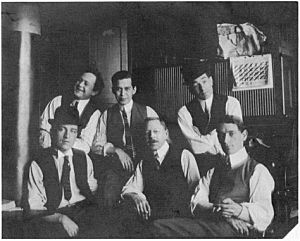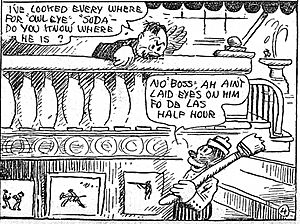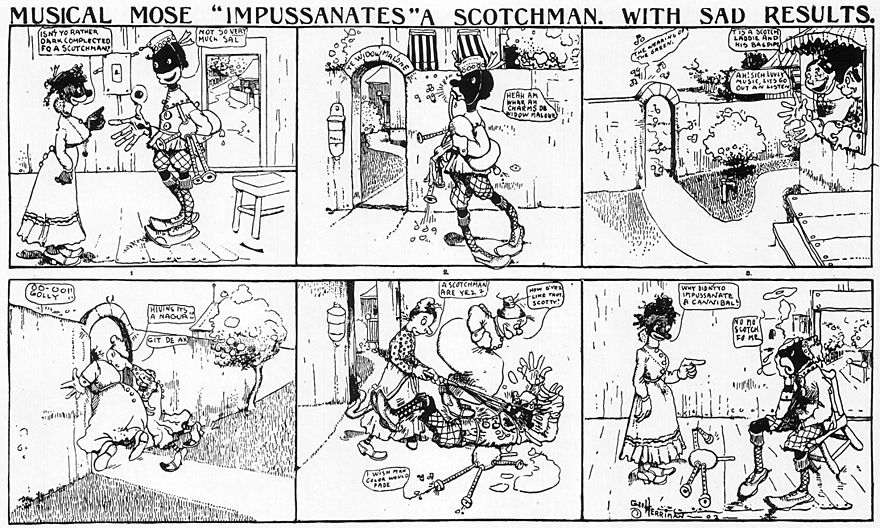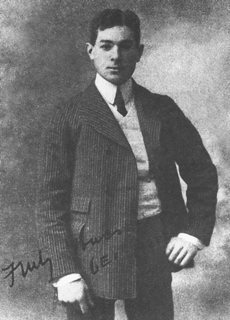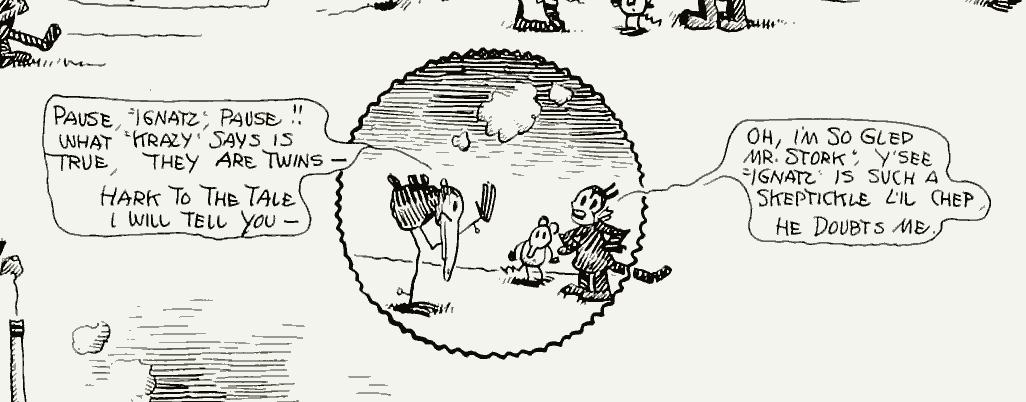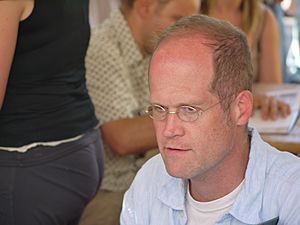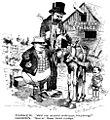George Herriman facts for kids
Quick facts for kids George Herriman |
|
|---|---|
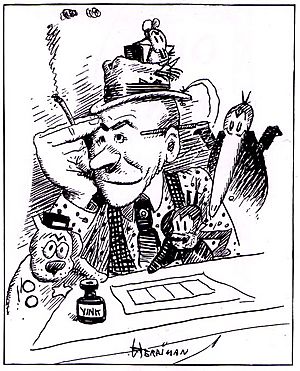
1922 self-portrait
|
|
| Born | George Joseph Herriman August 22, 1880 New Orleans, Louisiana, US |
| Died | April 25, 1944 (aged 63) Los Angeles, California, US |
| Area(s) | Cartoonist |
|
Notable works
|
Krazy Kat (1913–1944) |
| Spouse(s) |
Mabel Lillian Bridge
(m. 1902; died 1931) |
| Children | 2 |
| Signature | |
George Joseph Herriman III (August 22, 1880 – April 25, 1944) was an American cartoonist. He is most famous for his comic strip Krazy Kat (1913–1944). While not always super popular, Krazy Kat was loved by many artists and writers.
The Comics Journal even called it the best comic of the 20th century. Many famous cartoonists, like Charles M. Schulz (who created Peanuts), were influenced by Herriman's work.
Herriman was born in New Orleans, Louisiana. His parents were mixed-race Creole. He grew up in Los Angeles. After high school in 1897, he started working for newspapers. He drew pictures and helped with printing. Later, he began drawing comic strips, which were a new art form back then.
He created many strips before introducing his most famous character, Krazy Kat. Krazy Kat first appeared in his strip The Dingbat Family in 1910. A daily Krazy Kat strip started in 1913, and Sunday versions came out in 1916. The strip was known for its unique language, changing backgrounds, and creative page designs.
The main idea of Krazy Kat was a love triangle. Ignatz Mouse would throw bricks at Krazy Kat. The innocent Krazy Kat, whose gender was often unclear, thought these bricks were signs of love. Offisa Pupp, a dog, tried to stop Ignatz from throwing bricks. But Krazy Kat always wanted to be hit by Ignatz's bricks.
Herriman lived mostly in Los Angeles. However, he often visited the Navajo deserts in the Southwestern United States. He loved the landscapes of Monument Valley and the Enchanted Mesa. He made Coconino County the setting for his Krazy Kat strips. His art often used Navajo and Mexican designs against shifting desert scenes.
He drew many comic strips and also illustrated books. Newspaper owner William Randolph Hearst was a big fan of Herriman. Hearst gave him a special contract that guaranteed Herriman a good income and a place for his work. This was important because Krazy Kat was not always widely popular.
Biography
Early Life and Career (1880–1905)
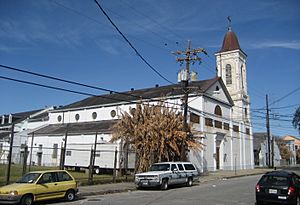
George Joseph Herriman was born in New Orleans on August 22, 1880. His family was mixed-race and came from Creole people in Louisiana. They were known as "free people of color" and were involved in the early movement to end slavery.
When George was ten, his family moved to Los Angeles. His father worked as a tailor there. George went to St. Vincent's College, a Catholic school for boys. After graduating in 1897, he sold a drawing to the Los Angeles Herald. This led to a job helping in the newspaper's printing department. He sometimes drew pictures for ads and political cartoons.
When he was 20, Herriman secretly traveled to New York City by freight train. He hoped to find better opportunities as an artist there. At first, he struggled and worked odd jobs, like painting billboards. But then, a popular humor magazine called Judge started accepting his cartoons.
Between June and October 1901, eleven of his cartoons appeared in Judge. He often used several pictures in a row, like in comic strips. In September that year, his first real comic strips were published. One was a one-time strip for the Pulitzer newspapers. Another was a continuing strip for the Philadelphia North American Syndicate.
His success with these strips convinced Herriman to focus on comics. In February 1902, he started his first strip with a continuing character, Musical Mose. This strip featured an African-American musician who pretended to be other types of people. He would then face problems when people found out.
Other strips followed, like Professor Otto and his Auto and Acrobatic Archie. With his cartooning career looking good, Herriman went back to Los Angeles. He married his childhood sweetheart and then returned with her to New York.
Herriman's work became more popular. He sometimes had full-color strips on the front page of newspapers. In January 1903, he started Two Jolly Jackies, about two unemployed sailors. In September, he began drawing the cowboy strip Lariat Pete.
In June 1903, Herriman started working for the New York World. He drew pictures for articles about local events. He also continued to create syndicated work. One popular strip was Major Ozone's Fresh Air Crusade, which began in January 1904. The Major was a character who traveled the world looking for the purest air. He often spoke in a poetic way.
In 1904, Herriman moved to the New York Daily News. There, he had more types of work, including drawing about sports and politics. He also had a short-lived strip about home life called Home Sweet Home.
Later, Rudolph Block hired Herriman for the Hearst newspapers. Herriman drew sports cartoons alongside other famous cartoonists. He became close friends with Tad Dorgan, another well-known artist. In 1924, Tad called Herriman "one of the best sporting artists in the world." Herriman stayed with Hearst until June 1905. He then returned to Los Angeles.
Return to California and New Strips (1905–1910)
In California, Herriman continued to send his work to the World Color Printing Company. He brought back Major Ozone and created new strips like Grandma's Girl—Likewise Bud Smith and Rosy Posy—Mama's Girl. He also started working with the Los Angeles Times in January 1906. That summer, he returned to Hearst.
His drawings started appearing on almost every page of Hearst's Los Angeles Examiner. This helped the newspaper sell many more copies. By October, he stopped working for World Color.
After the success of other daily strips, Herriman started his own sports-themed strip called Mr. Proones the Plunger in December 1906. It wasn't as successful and ended quickly. His next comic strip, Baron Mooch, about a freeloader, began in October 1909.
In November 1909, Herriman started two more color strips: Alexander the Cat and Daniel and Pansy. Daniel and Pansy was his first strip with only animal characters. This was followed by Mary's Home from College and Gooseberry Sprig. Gooseberry Sprig featured an aristocratic duck and other bird characters. Many of these characters later appeared in Krazy Kat.
The Birth of Krazy Kat (1910–1922)
In 1910, Herriman was called back to New York. He began a new strip called The Dingbat Family. On July 26, 1910, something important happened in this strip. A mouse threw a brick at the family cat, named "Kat." This small event led to the creation of Krazy Kat.
Herriman said he added the cat and mouse antics "to fill up the waste space" at the bottom of The Dingbat Family panels. About a month later, the "Kat" kissed the sleeping mouse. The mouse woke up saying, "I dreamed an angel kissed me."
The gender of "Kat" was never clear. Herriman would call Krazy "he" or "she" as he wished. Herriman also started adding unusual details to the backgrounds of the mini-strip. Things like cacti, pagodas, or strange plants became a special part of Krazy Kat. More characters joined, including Bull Pupp.
The cat-and-mouse story became very popular. It grew from a small part of The Dingbat Family to its own section. In July 1912, Krazy Kat and Ignatz Mouse took over the strip, which was briefly called Krazy Kat and I. Mouse. Finally, on October 28, 1913, Krazy Kat became its own daily comic strip.
Newspaper owner William Randolph Hearst personally supported the strip. Many readers weren't interested at first. But famous artists and writers, like Picasso, loved it. Later, writers like Jack Kerouac also became fans.
In its early years, Krazy Kat's humor changed. The backgrounds became more and more unusual. On April 23, 1916, the strip expanded to a full-page black-and-white Sunday strip. Herriman used the whole page to create imaginative and daring layouts. His strips were unlike anything else in the newspaper.
Herriman visited Monument Valley in Arizona and other desert places. He put the unique shapes of the desert into his strips. The Enchanted Mesa of New Mexico first appeared in Krazy Kat in 1916. The desert setting of Coconino County, Arizona, became the main backdrop for the strip.
The Dingbat Family ended in 1916. Herriman then started Baron Bean, about a poor English nobleman. This strip ran until January 1919. It was replaced by Now Listen Mabel, which lasted until December of that year.
Krazy Kat gained many fans in the art world. Krazy Kat even appeared in animated films starting in 1916. In 1922, a Krazy Kat ballet was created. Herriman designed the costumes and scenery for it.
A famous literary critic, Gilbert Seldes, wrote an article about Krazy Kat in Vanity Fair. He later expanded this into a chapter in his book The Seven Lively Arts. Seldes argued that popular artists like Herriman should be seen as important as traditional artists. This was a big step for comic strips to be taken seriously as an art form.
Later Career and Life (1922–1944)
Hearst had given Herriman a special lifetime contract. This meant Herriman could live wherever he wanted. In 1922, he moved back to Hollywood, California. He often visited the Arizona desert from his new home. Herriman became friends with people in the film industry, including writers for the Our Gang shorts. He met famous people like Will Rogers and Frank Capra. He also loved Charlie Chaplin's films.
In late 1922, Herriman started a new strip called Stumble Inn. It was about Uriah and Ida Stumble, who rented rooms to strange characters. The daily version was short, but the Sunday version lasted three years.
From 1925 to 1929, King Features (Hearst's company) asked Herriman to design Krazy Kat Sundays in a specific way. This was so they could be printed as a full page or split into two daily strips. Herriman didn't like this change, and his art during this time sometimes looked rushed. However, the famous Krazy—Ignatz—Offisa Pupp love triangle became fully developed during this period.
Throughout the late 1920s, Herriman often visited Kayenta, Arizona, near Monument Valley. He also traveled to Mexico in the winters. The desert, Navajo art, and Mexican designs became even more common in his strips. He sometimes used Spanish words in the dialogue.
Stumble Inn ended in 1925. It was replaced by Us Husbands, which ran until the end of that year. In 1928, Herriman took over another strip called Embarrassing Moments, which later became Bernie Burns. After this strip ended in 1932, Herriman worked only on Krazy Kat. He also drew pictures for Don Marquis' popular books about Archy and Mehitabel, a cat and a cockroach.
In 1930, Herriman moved to a new Spanish-style mansion in Hollywood. It was decorated with paintings of the Southwest and Native American themes. He even bought the lot across the street and turned it into a public park.
The 1930s were a sad time for Herriman. In 1931, his wife Mabel died after a car accident. In 1939, his youngest daughter Bobbie died unexpectedly at age 30. After his wife's death, Herriman never remarried. He lived in Los Angeles with his many cats and dogs.
Krazy Kat's popularity went down over the years. By the 1930s, it was only in about thirty-five newspapers. Other comics were in a thousand papers. Herriman knew his high salary from Hearst was more than the strip was earning. But Hearst refused to let him take a pay cut. Hearst wanted Herriman to continue the strip as long as he wished. From 1935, Krazy Kat appeared in color, and Herriman used colors boldly.
George Herriman died in his sleep at his home on April 25, 1944, after a long illness. He had been working on new daily strips. The New York Journal-American newspaper published an obituary on its front page. His funeral was small. Cartoonist Harry Hershfield spoke at the funeral, saying, "If ever there was a saint on earth, it was George Herriman." As he wished, his body was cremated, and his ashes were scattered over Monument Valley.
On June 25, 1944, two months after Herriman's death, the last Krazy Kat strip he completed was printed. Usually, Hearst would find new cartoonists for popular strips when the original artist died. But for Herriman, he made an exception. Hearst felt that no one could truly take his place.
Personal Life
Herriman was described as a modest person who didn't like having his picture taken. The New York Journal-American obituary said he was a loving husband and father. He was a kind person and quietly gave to charities. He was generous to his friends. He sold his first Hollywood house to a friend for less than he paid for it.
Though he was a private person, he was a fun host to his friends. Sometimes he would be quiet at social events. He would often leave the room to wash dishes, which he said he enjoyed because it gave him time to think. His favorite game was poker, especially with other cartoonists.
Herriman loved animals very much. He had many dogs and cats. In 1934, he had five dogs and thirteen cats! He usually ate a vegetarian diet. He also admired Henry Ford's peaceful views and only bought Ford cars. He bought a new model every year.
Herriman married his childhood sweetheart, Mabel Lillian Bridge, in Los Angeles on July 7, 1902. They had two daughters. Mabel (born 1903), nicknamed "Toodles" or "Toots," and Barbara (born 1909), nicknamed "Bobbie." Sadly, Bobbie died unexpectedly in 1939 at age 30.
Race and Identity
George Herriman was born to mixed-race parents. His birth certificate listed him as "colored." In the United States at that time, after the "separate but equal" laws, people of mixed race often had to choose to identify as either Black or white. Herriman seemed to identify himself as white.
Some of his early work included characters that were caricatures of Black people. For example, in Musical Mose, the main character, an African-American musician, wishes his "color would fade."
In Krazy Kat, there were also hints about race. Sometimes, Krazy's black fur would be dyed white. Ignatz would fall in love with the white Krazy, but then go back to hating Krazy and throwing bricks when the truth was revealed. Also, in a repeated joke, Ignatz would accidentally get covered in coal dust. Krazy would then avoid him. Once Ignatz was clean again, Krazy would love him.
Herriman's mixed heritage was not known to his friends or colleagues. Fellow cartoonist Tad Dorgan nicknamed him "the Greek," and this name stuck. People thought he was the son of a Greek baker. Other times, he was identified as French, Irish, or Turkish. He did tell a friend that he was Creole and wondered if he had "Negro blood" because he had "kinky hair." His friend said Herriman wore a hat to hide his hair. This might have been an attempt to pass as white. Herriman once said he dreamed of being reborn as a Navajo. On his death certificate, he was listed as "Caucasian."
In 1971, a sociologist named Arthur Asa Berger discovered Herriman's mixed-race heritage. He found Herriman's birth certificate, which listed his race as "colored." The 1880 census also listed his parents as "mulatto." After this, African-American poet Ishmael Reed dedicated his 1972 novel Mumbo Jumbo to "George Herriman, Afro-American, who created Krazy Kat." Since then, Herriman has been recognized as Black or Creole in books about comics. Later research also suggested he might have had Spanish or Native American ancestors.
Work and Style
Artistic Style
In Krazy Kat, Herriman was very creative with the story. He constantly changed the backgrounds and even the gender of Krazy Kat. He mixed different cultures in his work, like Navajo and Mexican influences. He used language in a poetic way, with playful puns and a mix of different dialects.
Herriman's characters were often aware they were in a comic strip. He would sometimes draw attention to himself or his drawings within the strip. He also showed how language and experience could be seen in different ways.
Cartoonist Edward Sorel described Herriman's drawing style as "liberated" and "spontaneous." His pen strokes were dynamic, with thick and thin lines that are easy to recognize. The Krazy Kat Sunday pages showed Herriman's most experimental work. Each one had a unique panel layout and logo. The panels could be circles, unusual shapes, or have no borders at all. In his last few years, Herriman's arthritis made his art style scratchier. He would use a knife to scratch out white areas from inked surfaces, making the art look like a woodcut.
Collected Works
Krazy Kat has been collected in many books over the years. However, Herriman's other comic strips have not been reprinted as often. The first Krazy Kat collection was published in 1946. It included an introduction by the poet E. E. Cummings.
Comics historian Bill Blackbeard started putting together a complete collection of Krazy Kat Sundays in 1988. Later, a thirteen-volume series called Krazy and Ignatz was published starting in 2002. This series was designed by Chris Ware.
In 2010, Sunday Press Books released Krazy Kat: A Celebration of Sundays. This book reprinted a selection of Krazy Kat Sundays and some of Herriman's earlier work. The book was very large, similar to the original size of the newspaper strips. Other publishers have also released collections of Herriman's other works, like Baron Bean and Stumble Inn.
List of Comic Strips
| Title | Begin date | End date |
|---|---|---|
| Musical Mose | February 16, 1902 | March 9, 1902 |
| Professor Otto and his Auto | March 30, 1902 | December 28, 1902 |
| Acrobatic Archie | April 13, 1902 | January 25, 1903 |
| Two Jollie Jackies | January 11, 1903 | November 15, 1903 |
| Lariat Pete | September 6, 1903 | November 15, 1903 |
| Major Ozone's Fresh Air Crusade | January 2, 1904 | October 20, 1906 |
| Home Sweet Home | February 22, 1904 | March 4, 1904 |
| Bud Smith | October 29, 1905 | October 20, 1906 |
| Mr. Proones the Plunger | December 7, 1906 | December 26, 1906 |
| Rosy Posy, Mama's Girl | May 19, 1906 | September 15, 1906 |
| Grandma's Girl | November 26, 1905 | May 19, 1906 |
| Baron Mooch | October 12, 1909 | December 19, 1909 |
| Mary's Home from College | February 19, 1909 | March 27, 1919 |
| Gooseberry Sprig | December 23, 1909 | January 24, 1910 |
| Alexander the Cat | November 7, 1909 | January 9, 1910 |
| Daniel and Pansy | November 21, 1909 | December 4, 1909 |
| The Dingbat Family/The Family Upstairs | June 20, 1910 | January 4, 1916 |
| Krazy Kat | October 28, 1913 | June 25, 1944 |
| Baron Bean | January 5, 1916 | January 22, 1919 |
| Now Listen Mabel | January 23, 1919 | December 18, 1919 |
| Stumble Inn | October 30, 1922 | October 30, 1925 |
| Us Husbands | January 9, 1926 | December 18, 1926 |
| Mistakes Will Happen | January 9, 1926 | December 18, 1926 |
| Embarrassing Moments/Bernie Burns | April 28, 1928 | December 3, 1932 |
Images for kids
-
The Herrimans attended St. Augustine Catholic Church in Tremé in New Orleans.
-
Krazy Kat daily strip — Krazy Kat kisses a sleeping Ignatz Mouse, who then dreams of cupids. (December 24, 1917)
-
Herriman loved the impressive rock formations at Monument Valley in Arizona.
See also
 In Spanish: George Herriman para niños
In Spanish: George Herriman para niños




